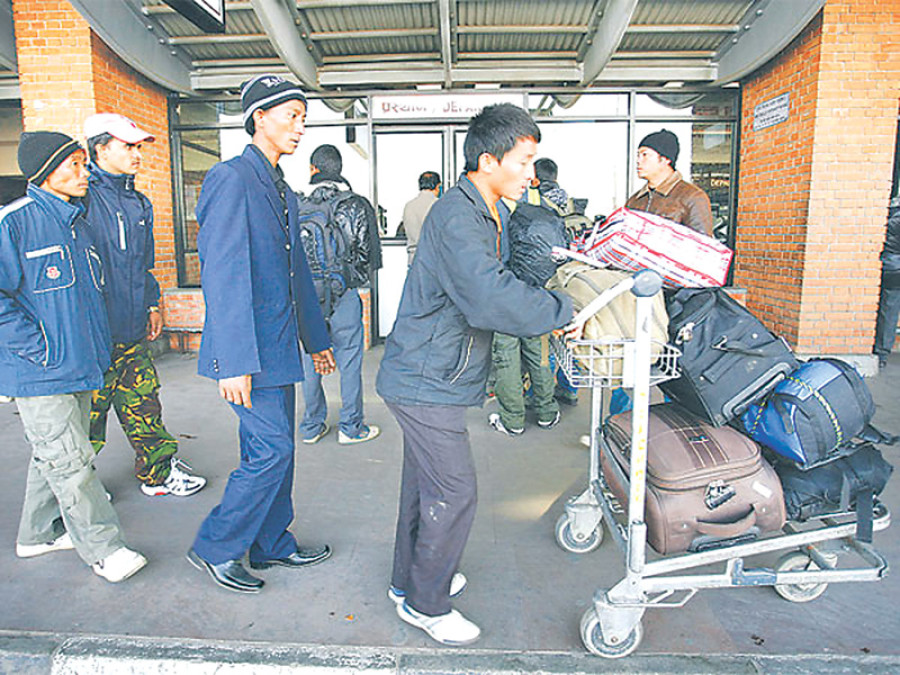Miscellaneous
No. of Nepalis leaving for foreign jobs drops sharply
The number of Nepali migrants going to work abroad dropped by around 16 percent in the first three months of the fiscal year 2016-17, according to the Department of Foreign Employment.
Roshan Sedhai
The number of Nepali migrants going to work abroad dropped by around 16 percent in the first three months of the fiscal year 2016-17, according to the Department of Foreign Employment.
Experts said that a growth in job opportunities at home could be the main reason for the fall in outmigration, while recruiting agencies cited the shrinking job demands, especially from Malaysia, one of the major overseas destinations for Nepali workers.
According to data compiled by the Department of Foreign Employment, a total of 95,193 Nepalis left the country for overseas jobs from mid-July to mid-October this year, down from 113,515 in the same period last year.
The “free fall” in the number of people going abroad has caused panic in the foreign employment sector. While recruiting agencies appear increasingly worried about sustainability of business, other stakeholders are apprehensive of possible decline in remittance—the lifeline of Nepali economy.
In 2015, remittance that Nepali received from various countries across the globe amounted to around 30 percent of GDP, according to Nepal Rastra Bank.
So far, the NRB has not witnessed a striking decline in inflow of remittance. According to the NRB, Nepal received Rs 51.94 billion in remittance between mid-July and mid-August this year, down from Rs 53.72 billion in the same period last year.
DoFE officials claim that the drop may be temporary, arguing that there has not been significant drop in job demands from abroad, especially the Gulf nations.
“We are especially seeing a drop in job demands from Malaysia because of temporary restriction by the government there to hire foreign workers. But demands for workers from other major work destinations have been giving job demands on par with previous years,” said a DoFE official.
Experts said that growing work opportunities at home may have prevented migrants, especially unskilled labourers that constitute over 70 percent of Nepal’s migrant workforce, from leaving the country. There is a huge demand for workers in the construction sector due to the reconstruction works of infrastructure damaged by last year’s devastating earthquake.
Nepal will need an estimated 700,000 skilled and unskilled workers for rebuilding works, according to the Post Disaster Needs Assessment report. More than 500,000 houses were destroyed and over 250,000 were damaged in the disaster, according to preliminary surveys. Out of them, 31,000 quake survivors have rebuilt their homes so far, according to the Central Bureau of Statistics.
Recruiting agencies in Nepal blame shrinking demand from the major work destination for the drop and do not look optimistic about the future.
They claim that there is a danger of collapse of the foreign employment industry if the government does not reconsider on the free-visa-fee-ticket policy—a low cost scheme that binds an employer to provide air tickets and visa for workers.
“Companies in Malaysia and the Gulf are looking for cheaper options in other countries for workers. Many Nepali recruiting agencies sending workers to Malaysia are on the verge of shutting down their business,” said Tanka Raut, former office bearer of the Nepal Association of Foreign Employment Agencies.
Quarterly report
2015-16 2016-17
July-Aug 37,756 35485
Aug-Sept 40,275 34759
Sept-Oct 35,484 24949




 10.12°C Kathmandu
10.12°C Kathmandu










